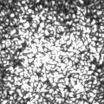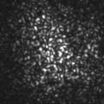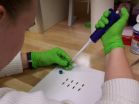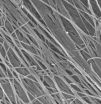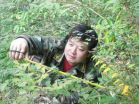(Press-News.org) VIDEO:
This video shows the rapid "twinkling " or intensity fluctuations of the speckle pattern in a drop of unclotted whole blood. The rapid "twinkling " is due to the fast thermally-driven motion...
Click here for more information.
WASHINGTON, Feb. 24—Defective blood coagulation is one of the leading causes of preventable death in patients who have suffered trauma or undergone surgery. The body's natural defense against severe blood loss is the clotting process, in which platelets, plasma proteins, and other blood components interact to form a sticky, mesh-like structure. But often things go wrong, and blood coagulates too little or too much.
To provide caregivers with timely information about the clotting properties of a patient's blood, researchers at Massachusetts General Hospital have developed an optical device that requires only a few drops of blood and a few minutes to measure the key coagulation parameters that can guide medical decisions, like how much blood to transfuse or what doses of anticoagulant drugs to administer. The researchers describe their new device in a paper published today in The Optical Society's (OSA) open-access journal Biomedical Optics Express.
"Currently, the most comprehensive measures of coagulation are a battery of lab tests that are expensive and can take hours to perform," said Seemantini Nadkarni, an assistant professor at the Wellman Center for Photomedicine at Massachusetts General Hospital and Harvard Medical School and senior author on the Biomedical Optics Express paper. She notes that other systems have been developed that provide clotting measurements at the point of care, but the systems can be big and expensive or have other limitations, such as requiring significant amounts of blood or only measuring clotting time.
VIDEO:
This video is taken from the same sample of blood featured in the Speckle Pattern in Unclotted Whole Blood video after 10 minutes. In this case, the time-varying fluctuations of...
Click here for more information.
"Our goal is to provide as much information as a lab test, but to provide it quickly and cheaply at a patient's bedside," Nadkarni said.
To reach this goal Nadkarni and her colleagues turned to an optical technique they pioneered called laser speckle rheology (LSR). In LSR, researchers shine laser light into a sample and monitor the patterns of light that bounce back. Nadkarni's team had previously used the technique to measure the mechanical properties of a range of different tissue types and found that it was extremely sensitive to the coagulation of blood.
When light hits a blood sample, blood cells and platelets scatter the light. In unclotted blood these light scattering particles move easily about, making the pattern of scattered light, called a speckle pattern, fluctuate rapidly.
"It's almost like looking at a starry night sky, with twinkling stars," Nadkarni said of the speckle pattern. "But as the blood starts to coagulate, blood cells and platelets come together within a fibrin network to form a clot. The motion is restricted as the sample get stiffer, and the twinkling of the speckle pattern is reduced significantly."
Nadkarni and her team used a miniature high-speed camera to record the fluctuating speckle pattern and then correlated the intensity of changes in the pattern with two important blood sample measurements: clotting time and concentration of fibrinogen, a protein that plays a key role in the clotting process. Doctors in an emergency room or performing surgery could use the measurements to make decisions about how much blood to give a bleeding patient and what type of blood product, for example platelets or fibrinogen, is needed most.
"The timely detection of clotting defects followed by the appropriate blood product transfusion is critical in managing bleeding patients," Nadkarni said. "If you transfuse too much, there could be further coagulation defects that occur, but if you don't transfuse enough, bleeding continues."
On the other end of the spectrum, Nadkarni says the device could also help patients whose blood coagulates too easily, forming clots inside of blood vessels in a condition called thrombosis. These patients take anticoagulation medications and must regularly visit labs to have their blood analyzed and the doses of the medications adjusted. Having a small device that could take the same measurements in a doctor's office or at home could reduce the cost and inconvenience, while increasing the safety of anticoagulation treatment, Nadkarni said.
"I look forward to working on the exciting next phase in which we plan to conduct clinical testing of the LSR device at the point of care in the operating room and in the doctor's office using just a drop or two of blood," said Markandey Tripathi, a postdoctoral fellow at the Wellman Center and lead author on the Biomedical Optics Express paper.
"Some other rapid devices exist but these have various disadvantages, ranging from poor correlation with central laboratory tests to skill required to interpret results," added Elizabeth van Cott, who is an associate professor of Pathology at Massachusetts General Hospital and Harvard Medical School, and a co-author on the paper. "The capability of the LSR device to provide rapid test results using small amounts of blood would be extremely valuable for patients particularly in operating suites, emergency departments, and intensive care units, as well as for any patient with a coagulation disorder."
Currently the optical device developed by Nadkarni and her colleagues is about the size of a tissue box and is connected to a computer. The team is working to further miniaturize the system and aims to perform clinical studies with a handheld version smaller than a cell phone within the next year.
INFORMATION:
Paper: "Assessing Blood Coagulation Status with Laser Speckle Rheology," M. Tripathi et al., Biomedical Optics Express, Vol. 5, Issue 3, pp. 817-831 (2014). http://www.opticsinfobase.org/boe/abstract.cfm?uri=boe-5-3-817
EDITOR'S NOTE: A video of the laser speckle technique is available to members of the media upon request. Contact Angela Stark, astark@osa.org.
About Biomedical Optics Express
Biomedical Optics Express is OSA's principal outlet for serving the biomedical optics community with rapid, open-access, peer-reviewed papers related to optics, photonics and imaging in the life sciences. The journal scope encompasses theoretical modeling and simulations, technology development, and biomedical studies and clinical applications. It is published by The Optical Society and edited by Joseph A. Izatt of Duke University. Biomedical Optics Express is an open-access journal and is available at no cost to readers online at http://www.OpticsInfoBase.org/BOE.
About OSA
Founded in 1916, The Optical Society (OSA) is the leading professional society for scientists, engineers, students and business leaders who fuel discoveries, shape real-world applications and accelerate achievements in the science of light. Through world-renowned publications, meetings and membership programs, OSA provides quality research, inspired interactions and dedicated resources for its extensive global network of professionals in optics and photonics. For more information, visit http://www.osa.org.
Medical researchers use light to quickly and easily measure blood's clotting properties
New approach could help doctors and surgeons diagnose blood coagulation status in near real time, significantly improving patient care
2014-02-24
ELSE PRESS RELEASES FROM THIS DATE:
NIST microanalysis technique makes the most of small nanoparticle samples
2014-02-24
Researchers from the National Institute of Standards and Technology (NIST) and the Food and Drug Administration (FDA) have demonstrated that they can make sensitive chemical analyses of minute samples of nanoparticles by, essentially, roasting them on top of a quartz crystal. The NIST-developed technique, "microscale thermogravimetric analysis," holds promise for studying nanomaterials in biology and the environment, where sample sizes often are quite small and larger-scale analysis won't work.*
Chemical analysis of nanoparticles is a challenging task, and not just because ...
New biological scaffold offers promising foundation for engineered tissues
2014-02-24
Our cells don't live in a vacuum. They are surrounded by a complex, nurturing matrix that is essential for many biological functions, including growth and healing.
In all multicellular organisms, including people, cells make their own extracellular matrix. But in the lab, scientists attempting to grow tissue must provide a scaffold for cells to latch onto as they grow and proliferate. This engineered tissue has potential to repair or replace virtually any part of our bodies.
Typically, researchers construct scaffolds from synthetic materials or natural animal or human ...
Is previous hypoglycemia a risk factor for future hypoglycemic episodes?
2014-02-24
New Rochelle, NY, February 24, 2014—The automatic "threshold suspend" (TS) feature of an insulin pump helps prevent life-threatening hypoglycemic events when the device's sensor detects blood glucose concentrations below the preset threshold. However, in individuals with type 1 diabetes who have had previous episodes of hypoglycemia the TS feature may be less effective at preventing subsequent events, according to important new results from the ASPIRE study published in Diabetes Technology & Therapeutics (DTT), a peer-reviewed journal from Mary Ann Liebert, Inc., publishers. ...
Vitamin water: Measuring essential nutrients in the ocean
2014-02-24
The phrase, 'Eat your vitamins,' applies to marine animals just like humans. Many vitamins, including B-12, are elusive in the ocean environment.
University of Washington researchers used new tools to measure and track B-12 vitamins in the ocean. Once believed to be manufactured only by marine bacteria, the new results show that a whole different class of organism, archaea, can supply this essential vitamin. The results were presented Feb. 24 at the Ocean Sciences meeting in Honolulu.
"The dominant paradigm has been bacteria are out there, making B-12, but it turns ...
OU researcher and team discover disease-causing bacteria in dental plaque preserved for 1,000 years
2014-02-24
When a University of Oklahoma researcher and an international team of experts analyzed the dental calculus or plaque from teeth preserved for 1,000 years, the results revealed human health and dietary information never seen before. The team discovered disease-causing bacteria in a German Medieval population, which is the same or very similar to inflammatory disease-causing bacteria in humans today—unlikely scientific results given modern hygiene and dental health practices.
Christina Warinner, research associate in the Molecular Anthropologies Laboratories, OU College ...
Gauging what it takes to heal a disaster-ravaged forest
2014-02-24
Recovering from natural disasters usually means rebuilding infrastructure and reassembling human lives. Yet ecologically sensitive areas need to heal, too, and scientists are pioneering new methods to assess nature's recovery and guide human intervention.
The epicenter of China's devastating Wenchuan earthquake in 2008 was in the Wolong Nature Reserve, a globally important valuable biodiversity hotspot and home to the beloved and endangered giant pandas. Not only did the quake devastate villages and roads, but the earth split open and swallowed sections of the forests ...
Penn researchers 'design for failure' with model material
2014-02-24
When deciding what materials to use in building something, determining how those materials respond to stress and strain is often the first task. A material's macroscopic, or bulk, properties in this area — whether it can spring back into shape, for example — is generally the product of what is happening on a microscopic scale. When stress causes a material's constituent molecules to rearrange in a way such that they can't go back to their original positions, it is known as "plastic deformation."
Researchers at the University of Pennsylvania have devised a method to study ...
Parents' attitudes about helping their grown children affect their mental health
2014-02-24
Older parents frequently give help to their middle-aged offspring, and their perceptions about giving this help may affect their mental health, according to a team of researchers.
"We usually view the elderly as needy, but our research shows that parents ages 60 and over are giving help to their children, and this support is often associated with lower rates of depression among the older adults," said Lauren Bangerter, Ph.D. student in human development and family studies, Penn State.
The team -- which included researchers at Penn State, the University of Texas ...
Specialized cognitive therapy improves blood sugar control in depressed diabetes patients
2014-02-24
Although maintaining good blood sugar control is crucial for avoiding complications of diabetes, it has been estimated that only about half of patients are successful in meeting target blood glucose levels. The prevalence of depression among diabetes patients – up to twice as high as in the general population – can interfere with patients' ability to manage their diabetes. Now a group of Massachusetts General Hospital (MGH) investigators report that a program of cognitive behavioral therapy that addresses both mood and diabetes self-care led to improved blood sugar control ...
Almost 200 new species of parasitoid wasps named after local parataxonomists in Costa Rica
2014-02-24
An inventory of wild-caught caterpillars, its food plants and parasitoids, has been going on for more than 34 years in Area de Conservación Guanacaste (ACG), a protected area of approximately 1200 km2 in northwestern Costa Rica. As a result, more than 10,000 species of moths and butterflies are estimated to live in ACG. Their caterpillars are in turn attacked by many parasitoid wasps, also numbering thousands of species. However, most of those wasps have never been described and remain unknown.
For the past few years researchers from Canada, Costa Rica and the United ...
LAST 30 PRESS RELEASES:
Tracing the quick synthesis of an industrially important catalyst
New software sheds light on cancer’s hidden genetic networks
UT Health San Antonio awarded $3 million in CPRIT grants to bolster cancer research and prevention efforts in South Texas
Third symposium spotlights global challenge of new contaminants in China’s fight against pollution
From straw to soil harmony: International team reveals how biochar supercharges carbon-smart farming
Myeloma: How AI is redrawing the map of cancer care
Manhattan E. Charurat, Ph.D., MHS invested as the Homer and Martha Gudelsky Distinguished Professor in Medicine at the University of Maryland School of Medicine
Insilico Medicine’s Pharma.AI Q4 Winter Launch Recap: Revolutionizing drug discovery with cutting-edge AI innovations, accelerating the path to pharmaceutical superintelligence
Nanoplastics have diet-dependent impacts on digestive system health
Brain neuron death occurs throughout life and increases with age, a natural human protein drug may halt neuron death in Alzheimer’s disease
SPIE and CLP announce the recipients of the 2025 Advanced Photonics Young Innovator Award
Lessons from the Caldor Fire’s Christmas Valley ‘Miracle’
Ant societies rose by trading individual protection for collective power
Research reveals how ancient viral DNA shapes early embryonic development
A molecular gatekeeper that controls protein synthesis
New ‘cloaking device’ concept to shield sensitive tech from magnetic fields
Researchers show impact of mountain building and climate change on alpine biodiversity
Study models the transition from Neanderthals to modern humans in Europe
University of Phoenix College of Doctoral Studies releases white paper on AI-driven skilling to reduce burnout and restore worker autonomy
AIs fail at the game of visual “telephone”
The levers for a sustainable food system
Potential changes in US homelessness by ending federal support for housing first programs
Vulnerability of large language models to prompt injection when providing medical advice
Researchers develop new system for high-energy-density, long-life, multi-electron transfer bromine-based flow batteries
Ending federal support for housing first programs could increase U.S. homelessness by 5% in one year, new JAMA study finds
New research uncovers molecular ‘safety switch’ shielding cancers from immune attack
Bacteria resisting viral infection can still sink carbon to ocean floor
Younger biological age may increase depression risk in older women during COVID-19
Bharat Innovates 2026 National Basecamp Showcases India’s Most Promising Deep-Tech Ventures
Here’s what determines whether your income level rises or falls
[Press-News.org] Medical researchers use light to quickly and easily measure blood's clotting propertiesNew approach could help doctors and surgeons diagnose blood coagulation status in near real time, significantly improving patient care
